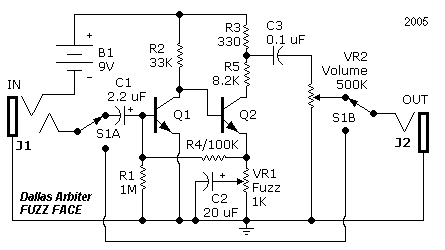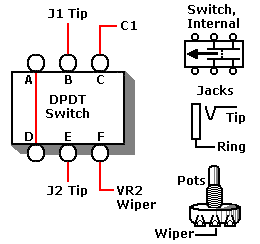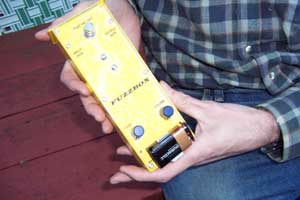Fuzzboxes you can makeA vintage circuit that would give you a tone like Jimi Hendrix and Jorma Kaukonen: What would you pay for such a circuit? $200? $300? $1,000? Now you can build this circuit yourself. Use common, but top-quality parts, and pay $100 or less. The "or less" depends solely on your junkbox and your skill. AdvantagesReal McCoy. Analog fuzz sounds different because it is different. When you want an analog effect, don't make do with a digital fake. Go with a real fuzzbox: Then you're back to simple construction and sweet sound. But the cost! Not to worry. The price can be much less than the cost of a factory unit or even a kit. Benefits. This version of the Dallas Arbiter fuzzbox offers many advantages over other versions. Modern, silicon transistors make the unit more reliable than the original germanium devices. The parts are easy to find, and we help with sources. Our Troubleshooting & Mods page helps you to adjust the tone to your need. The effect circuit fits onto a little piece of perfboard. We explain perfboard construction, because it differs from other methods. Why perfboard? Because it's inexpensive. Because it's the best way to achieve an effect that's both reliable and serviceable. Consider these perfboard facts...
I built this fuzzbox for my nephew Jonathan who had then just joined a garage band. (His brother Jason was the drummer.) PartsNPN swap & input resistor. My circuit uses NPN transistors instead of the PNP devices in the original Fuzz Face. The NPN swap is an easy and worthwhile change to make. More general-purpose NPN devices than PNP devices will work in this circuit. Besides, most people relate better to NPN operation than to PNP operation. There's no big secret to the conversion. You flip the battery and then you reverse all other polarized devices. Done. I've also added one resistor to the classic design. The one-megohm pulldown resistor at the base of transistor Q1 reduces noise. Depend on silicon. The transistors are silicon. I've heard that "silicon transistors have too much gain for this circuit." This statement is illogical. Thousands of different silicon devices exist. Among them are low-gain parts. Besides, the device doesn't necessarily determine gain. The circuit has a great effect on gain. Later, I'll explain more about the circuit. To avoid gain problems, I hand-picked two transistors from my stock of old devices. (These devices come from Dayton Hamvention. My old stock consists of mostly "pull-outs" from old equipment.) According to my homemade beta meter, the transistors that I chose had gains around 100. The original germanium devices had these gains: Q1, 70. Q2, 120. On gain, I'd say that I'm in the ballpark. Equivalent partsYou can use many general-purpose, small signal transistor types: 2N2222A, PN2222A, 2N3904, 2N4401, 2N5089, BC108, BC109C or many others. Though these transistors have gains of around 200, circuit adjustments can tame the angry silicon beasts. When I last checked, you could buy several fuzzbox-compatible transistors at All Electronics...
Fuzzbox Schematic
|
Parts list
Switch wiring
|
||||||||||||||||||||||||||||||||||||||||
Go to Page: 1 2 3 4 5 Next
- Advantages
- Depend on silicon
- Parts
- Equivalent parts
- Where to find parts
- Low-gain transistors
- Assembly tips
- Build the circuit board
- Build the case
- Test the effect
- Troubleshooting & Mods
- For softer fuzz, add a stabilizer
- Why you want silicon transistors
- Schematic: Fuzzbox
- Schematic: Switch wiring
- Schematic: More bass
- Schematic: Reduced, sweeter fuzz
